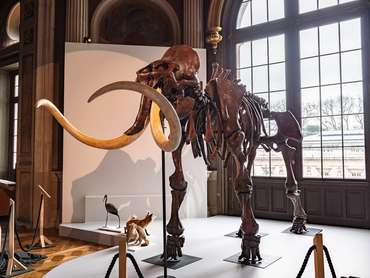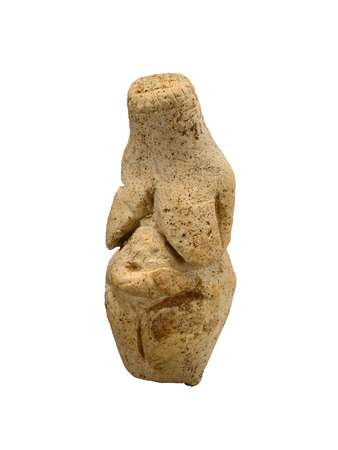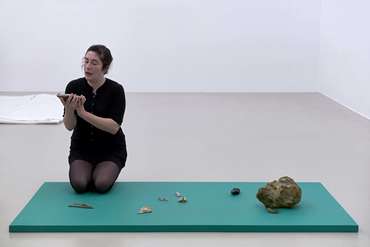Exhibition
The Somme in the time of Prehistoric Man
It was between Abbeville and Amiens that prehistory first emerged as a scientific discipline in the mid-19th century. Today, this region remains an essential site of research for those hoping to understand the life of prehistoric man. The Somme basin offers a favourable context for the conservation of deposits, from the remains of the first human populations in Northern Europe 700,000 years ago, to the last appearances of hunter-gatherer populations before the advent of agriculture around 7,000 years ago. Over the last thirty years, major and at times unprecedented discoveries have been made in this department. Prehistorians study remains, formulate hypotheses and make use of modern technology every day to continue advancing our knowledge. However, there are fields which remain a mystery to this day, like the beliefs or social organisation of our distant predecessors. A certain creative drive has slipped into this gap in our knowledge, fuelling our collective imaginary – sometimes to the detriment of discernible truths.
This exhibition invites you on a journey into Prehistory: that written by specialists over the course of their research and that which all of us imagine, rightly or wrongly.

I. To each their own Prehistory ?
Since the recognition of Prehistory, in around 1859, society has seized on scientific discoveries or theories to put this period into images or words. While specialists debate they way in which deposits and objects should be analysed, artists and writers share their own imaginary around Prehistory and prehistoric man. These works are rooted in the society and representations of their times. But prehistory, which is the study of mankind before history, is itself understood by scientists who are products of their time. Ideas, analyses and clever hypotheses can also be influenced by contemporary thinking.
What if, ultimately, Prehistory could also reveal something about us- ? Like permanent traits inherent to the human species, or truths about us as men and women of our times, about our ways of thinking, structured by the society in which we exist ? Is it possible to imagine an otherness, freed from our presuppositions ?
The adoption of Prehistory by 19th-century artists
These paintings of prehistoric subjects, created at the time of the scientific discipline's birth, reveal the studies of artists who often take great care to document their work. However, they deal with deeply human and timeless themes: survival, violence, sexuality, family and death. Though these works illustrate how artists saw our distant predecessors and their social codes, they also reveal the preoccupations, tastes and fantasies of their own society.
II. The establishment of a science
In the early decades of the 19th century, scientists were particularly active, criss-crossing Europe in pursuit of "global archives". From the 1840s onwards, archaeologists, naturalists, palaeontologists and geologists working between Paris and London began to converge. With different methodological tools, they all set off on identical quests into the origin and antiquity of mankind. In the field, they offered decisive proof that the human species had in fact lived alongside animals now extinct or having moved far from our shores thousands of years ago, in pursuit of a more suitable climate. Despite some opposition, a consensus began to form. On 15 September 1859, the British geologist Charles Lyell announced that he recognised the evidence discovered of mankind's existence in prehistoric times as valid. Leading French scientific institutions also came out in agreement with these conclusions. This was the birth of Prehistory.
1.Jacques Boucher de Perthes (1788–1868)
"Boucher de Perthes did it all! Philosophy, history, poetry, literature, novels and, on top of it all, prehistory, as unscientific as it gets, with pieces of inane stone figures and not a trace of geological thinking. A century on, it's hilarious to think, and yet prehistory was born from it, but oh the work that had to be done!"
Abbott Henri Breuil, 1937
Despite sometimes confusing methods, a few daring theses and the mishmash of his collections, this Abbeville man remains a decisive actor in the recognition of mankind's ancient history, thanks to his stubbornness in defending his ideas, the accuracy of his observations and his capacity to build networks to benefit his cause, whether made up of leading scientists from both sides of the Channel or of more modest informants, like the quarry workers of Abbeville who brought him their latest finds.
2. A troubled birth
Accepting prehistory as a discipline in itself was no mean feat. Various scientific and religious obstacles arose, against the backdrop of a rivalry between French and English specialists, geologists and palaeontologists. Boucher de Perthes, a controversial figure, served as a matrix in this respect: opponents and followers alike set out to determine relevant analytical criteria upon which to base their judgements on his discoveries. The geologist Albert Gaudry presented an argument in favour of the Abbeville native, in an 1859 memo to the French Academy of Sciences, though its text was truncated upon publication; he then provided a full reading to the French Geological Society.
3. The context of the first discoveries
In the Somme, prehistoric discoveries have been, first and foremost, linked to economic and industrial development. The railway and its ballast requirements, along with the construction of factories and the city's expansion requiring brick and cob: all these factors led to the opening of quarries. When digging several metres below surface level to extract gravel and earth, workers discovered fossilised remains and cut stones that captured scientists' attention. The Amiens districts of Saint-Acheul and Montières, along with Abbeville and the Menchecourt district, therefore played a key role in the establishment of scientific proof.
4. From axe to handaxe: the biface and the Acheulean
The biface, a typical Early and Middle Palaeolithic piece, became the symbol of Prehistory as a whole. Several facts explain this. For Jacques Boucher de Perthes, first of all, tools allowed man to compensate for his inferiority in the world, and his attention became focused on the "primitive axe", as he referred to it. After him, Gabriel de Mortillet chose to name the oldest material culture known at that time after the Amiens Saint‑Acheul deposit, defined by what he referred to as a "coup‑de‑poing", or "handaxe". He therefore invented the Acheulean, an iconic term in prehistory, still used by specialists around the world. The name "biface" did not appear until 1920, in a text by André Vayson de Pradennes, who was the first to propose a more objective technical and descriptive vocabulary, moving away from our contemporary references.
III. Studying Prehistory today
Since the first discoveries in the 19th century, prehistoric research has been transformed. Today, it is closely linked to land-use planning, with the development of preventive archaeology some 30 years ago. Excavation and laboratory-study methods have also changed: in contrast to the search for the "beautiful object" of the 19th century, today, all remains and data are collected and subsequently processed by a multidisciplinary team. A dozen researchers can be involved in the study of a single deposit.
Analytical methods have been adapted, turning to the most modern technology. The aim is no longer to simply understand man's antiquity. Instead, the questions are now multiple: in which climates and landscapes did prehistoric people live? How did groups of hunter-gatherers live? How were their settlements organised? This discipline has evolved significantly over the last 170 years!
IV. The succession of climates over 1 million years
For 1 million years, the climate has undergone large-scale cyclical variations, characterised by alternating long cold periods, known as glacial periods, and much shorter temperate intervals referred to as interglacial periods. Between each period, intermediary episodes occur, slow when cooling and rapid when heating. These variations are caused by the eccentricity of the Earth's orbit, the tilt of its axis and the gradual change of its orientation (Milankovitch theory).
These shifts influenced environments in the north of France: deciduous forests (oak, beech) in temperate phases, and real polar deserts during glacial phases, with boreal forests (pine and birch) during intermediate phases. These fluctuating landscapes have resulted in the presence of very different animal species and human groups.
Milankovitch's theory explained in 2'52" by Géodéo
The carving of the Somme Valley through climate changes over the course of 1 million years
1. The humans of Prehistory
Few fossils have been discovered in the Somme, but a human presence has been attested to since the ancient period. Acheuleans settled around Abbeville some 670,000 years ago. These were, undoubtedly, Homo heidelbergensis, with archaic traits (low skull, still presenting a modest volume) and a massive build (under 1.70 m tall and weighing 80 kg). They are known for their hunting skills, the occasional use of fire and some symbolic behaviours.
Neanderthals have been documented in the Nord department thanks to two fragmented skulls in Biache‑Saint‑Vaast, dating back 250,00 years. They present a significant endocranial volume, a rounded protrusion above the‑ eye sockets and a protuberance at the back ‑of the skull, typical of Neanderthals. Neanderthals invented various stone-cutting techniques to produce their tools. Some buried their dead, while others ate them.
Finally, in the Somme, Homo sapiens – very similar to us with their rounded skulls, upturned foreheads and chins – have left spectacular proof of their artistic abilities.
2. A journey along the Somme, through the climates
Various deposits have been discovered in the Somme valley from the 19th century onwards. They cover the entirety of Prehistory, from the Lower Palaeolithic, 670,00 years ago, to the last hunter-gatherers of the Mesolithic era. The various human beings who have followed one after the other in our region have left traces of their activities and lifestyles behind them.
18 sites have been selected for this exhibition. Each illustrates one or several important questions about our knowledge of Prehistory in the north of France. Thanks to dating and palaeoenvironmental studies, we can also situate them within their palaeoclimatic setting (temperate, glacial, intermediate) and recreate their landscapes.
3. Animals and climates
For prehistoric fauna living in Europe, northern France was an essential passageway. This, therefore, explains the many deposits of animal remains observed in the Somme. These have made it possible to follow climate changes and indicate which animals adapted, evolved or disappeared. Herbivores offer the most information, as they are directly linked to changes in vegetation during each period: temperate, transitory and glacial. The vegetation cover of the Somme responds more rapidly and more definitively to climate change, with very specific wildlife.
V. The Amiens-Renancourt 1 site
Until the 2010s, we knew very little about the Upper Palaeolithic period in the north of France. Climate conditions appeared too harsh for men to have lived in the region at this time. However, in 1910, Victor Commont discovered a deposit in a Renancourt-Les-Amiens brickyard. 100 years later, as part of the development of an urban development zone in this suburb, by then a district of Amiens, surveys and, subsequently, excavation were carried out. At a depth of 4 metres, a Gravettian settlement was discovered, abandoned 27,00 years ago, yet perfectly conserved. Though this occupation took place during the last glacial period, the archaeological level documents a climate improvement lasting just a few centuries, promoting the return of vegetation, herds and, as a result, human groups. Up to 2023, over 180 m² of pits have been explored, with nearly 100,000 remains collected: carved flints, animal bones, bone and mammoth-ivory tools, as well as rarer ornaments and chalk statuettes.
Les Vénus au bout des doigts - digital application to discover the statuettes of Amiens-Renancourt from every angle
1. Understanding the site
Amiens, Renancourt 1
Date: 27,000 before present
Humanity: Homo sapiens
Excavation date: 2011 to 2023
Question:
>Human occupation in the north of France during the last ice age
> The extension of Gravettian culture in the north of France
Some 20 researchers are currently working to define the lifestyle of the Gravettian group that settled on this site, from their surrounding environment to the activities carried out here. The deposit is located near a steep-sided valley, ideal for the passage and hunting of game. The settlement corresponds to an area of activity, but it is hard to precisely define the exact location of the dwelling. The exceptional state of the remains' conservation has facilitated studies which have renewed our knowledge of modern man in the north-western Europe.
2. The Amiens-Renancourt 1 statuettes

The discovery of statuettes is extremely rare in Western Europe. Until this discovery, only around 15 were known in France. The 20 whole or fragmentary specimens collected in Renancourt therefore make it a major site.
The fragmentation of these pieces is the result of their production process and conservation conditions. Before burial, we imagine that these may have been dropped and trampled upon. Intentional breakages are also possible. After burial, the freezing caused by the glacial period may have caused them to explode.
Part of this production has been left on site, while others can‑ be extracted.
The study of these statuettes is still ongoing; this is, therefore, the first time that a selection has been presented to the public.
IV Louise Hervé and Clovis Maillet, Future Lithic Reduction

Echoing the 'The Somme in the time of Prehistoric Man" exhibition, the "Future Lithic Reduction" performance by Louise Hervé and Clovis Maillet brings ancient objects back to life: tools carved by and for human hands, but which museum visitors no longer have the right to touch. The duo have taken their inspiration from the concept of educational transmission in order to hijack its codes, mixing humour and intellect. The work tackles the idea of prehistoric gynocracy – in ‑other words, government by women – and various archaeological hypotheses surrounding its possible existence from the 19th century to the modern day, in particular with the reappropriation of these theories by eco‑-feminists in the 1970s.
Louise Hervé and Clovis Maillet founded the I.I.I.I. (International Institute for Important Items) in 2001, through which the artistic duo have created performances, genre films and installations. In their work, creation goes hand in hand with transmission, and the codes of university research or the guided tour are flipped on their heads to question the ways in which we share knowledge. Shaking up the hierarchy of knowledge, the duo tackles sociopolitical action or memory, history and feminism, through both humour and intellect.
A few explanations
Prehistory or prehistory?
Prehistory with a capital letter: the period.
prehistory without a capital letter: the scientific discipline.
Dating before present: bearing in mind the depth of time in Prehistory, we date before present and not before Jesus‑Christ (B.C.).
Quaternary: the most recent geological period on the geological time scale (2.6 million years ago).
Pleistocene and Holocene: subdivisions of the Quaternary. The Pleistocene was marked by a succession of glacial and interglacial periods (2.6 million years to 11,700 years before present), while the Holocene corresponds to the current period.
Sediment: particle deposit transported by water (alluvium), wind (loess) or the slow downslope flow of saturated soil, known as solifluction (colluvium).
The Gravettian?
The Gravettian is a Late Palaeolithic culture that developed in Europe 33,000 to 26,000 years before present.
